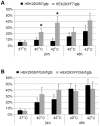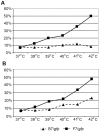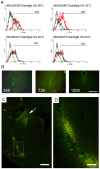Functional analysis of Drosophila HSP70 promoter with different HSE numbers in human cells
- PMID: 25101947
- PMCID: PMC4125163
- DOI: 10.1371/journal.pone.0101994
Functional analysis of Drosophila HSP70 promoter with different HSE numbers in human cells
Abstract
The activation of genetic constructs including the Drosophila hsp70 promoter with four and eight HSE sequences in the regulatory region has been described in human cells. The promoter was shown to be induced at lower temperatures compared to the human hsp70 promoter. The promoter activity increased after a 60-min heat shock already at 38 °C in human cells. The promoter activation was observed 24 h after heat shock for the constructs with eight HSEs, while those with four HSEs required 48 h. After transplantation of in vitro heat-shocked transfected cells, the promoter activity could be maintained for 3 days with a gradual decline. The promoter activation was confirmed in vivo without preliminary heat shock in mouse ischemic brain foci. Controlled expression of the Gdnf gene under a Drosophila hsp70 promoter was demonstrated. This promoter with four and eight HSE sequences in the regulatory region can be proposed as a regulated promoter in genetic therapeutic systems.
Conflict of interest statement
Figures












Similar articles
-
Combination of two regulatory elements in the Tetrahymena thermophila HSP70-1 gene controls heat shock activation.Eukaryot Cell. 2008 Feb;7(2):379-86. doi: 10.1128/EC.00221-07. Epub 2007 Nov 30. Eukaryot Cell. 2008. PMID: 18055912 Free PMC article.
-
Response of heat shock element within the human HSP70 promoter to mutated p53 genes.Cell Growth Differ. 1995 Jan;6(1):1-8. Cell Growth Differ. 1995. PMID: 7718482
-
Transfection and heat-inducible expression of molluscan promoter-luciferase reporter gene constructs in the Biomphalaria glabrata embryonic snail cell line.Am J Trop Med Hyg. 1998 Sep;59(3):414-20. doi: 10.4269/ajtmh.1998.59.414. Am J Trop Med Hyg. 1998. PMID: 9749636
-
Conserved function in Nicotiana tabacum of a single Drosophila hsp70 promoter heat shock element when fused to a minimal T-DNA promoter.Mol Gen Genet. 1989 Oct;219(1-2):9-16. doi: 10.1007/BF00261151. Mol Gen Genet. 1989. PMID: 2559318
-
Isolation of a novel inducible rat heat-shock protein (HSP70) gene and its expression during ischaemia/hypoxia and heat shock.Biochem J. 1994 Mar 15;298 Pt 3(Pt 3):561-9. doi: 10.1042/bj2980561. Biochem J. 1994. PMID: 8141767 Free PMC article.
Cited by
-
Single vector non-leaky gene expression system for Drosophila melanogaster.Sci Rep. 2017 Jul 31;7(1):6899. doi: 10.1038/s41598-017-07282-w. Sci Rep. 2017. PMID: 28761084 Free PMC article.
-
Screening and Structural Characterization of Heat Shock Response Elements (HSEs) in Entamoeba histolytica Promoters.Int J Mol Sci. 2024 Jan 21;25(2):1319. doi: 10.3390/ijms25021319. Int J Mol Sci. 2024. PMID: 38279319 Free PMC article.
-
The neuropeptide allatostatin C from clock-associated DN1p neurons generates the circadian rhythm for oogenesis.Proc Natl Acad Sci U S A. 2021 Jan 26;118(4):e2016878118. doi: 10.1073/pnas.2016878118. Proc Natl Acad Sci U S A. 2021. PMID: 33479181 Free PMC article.
-
Methanol-Free Protein Expression in Komagataella phaffii With Magnetic or Non-Magnetic Heating.Microb Biotechnol. 2025 Jun;18(6):e70183. doi: 10.1111/1751-7915.70183. Microb Biotechnol. 2025. PMID: 40515638 Free PMC article.
-
Responses of HSP70 Gene to Vibrio parahaemolyticus Infection and Thermal Stress and Its Transcriptional Regulation Analysis in Haliotis diversicolor.Molecules. 2019 Jan 3;24(1):162. doi: 10.3390/molecules24010162. Molecules. 2019. PMID: 30609869 Free PMC article.
References
Publication types
MeSH terms
Substances
LinkOut - more resources
Full Text Sources
Other Literature Sources
Molecular Biology Databases

